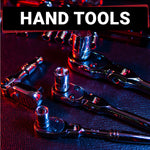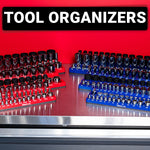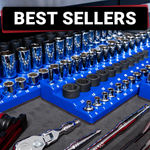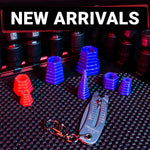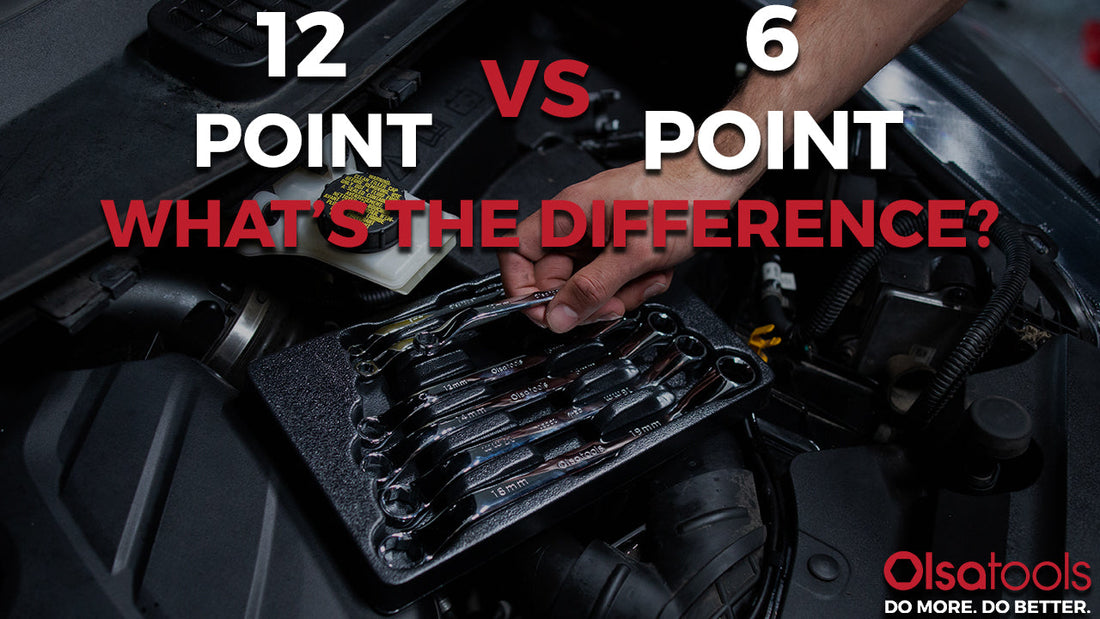The main difference between 6-point and 12-point sockets is their internal geometry. 6-point sockets have six contact points for maximum grip strength, while 12-point sockets offer twelve contact points for easier engagement at different angles.
Explore each socket type's advantages and best applications so you always choose the right socket for the job.
About 6-Point Sockets
A 6-point socket features six flat internal surfaces that match the sides of a hex fastener. The socket's internal geometry forms a hexagonal shape with 60-degree angles between each point. This basic tool design puts force across the fastener's flat sides instead of its corners.
The socket wall is thick between surface contact points, which creates a robust structure that resists stress. Each internal face meets the bolt-head walls for an exact fit. Thick walls also protect the socket from deformation under pressure.
Six-point sockets are made from premium materials such as chrome vanadium (Cr-V) or chromium-molybdenum (Cr-M) steel. These metals are exceptionally strong and durable. The production process includes heat treatment to increase durability, plus a chrome finish that stops rust and keeps operation smooth.
The socket's working end (the hex opening) fits over nuts and bolts, while the opposite end has a square opening for drive tools: low-tooth ratchets, breaker bars, and extensions. These snap-on tools come in common drive sizes (1/4, 3/8, and 1/2-inch ).
Professional mechanics prefer 6-point tools for high-stress tasks such as stuck head bolts and applications that require impact sockets.
About 12-Point Sockets
A 12-point socket features twelve internal contact points spaced evenly at 30-degree angles. The socket's internal geometry creates a double-hexagon shape that fits both 6-point and 12-point fasteners.
This design offers twice as many positions to engage a hex bolt or nut, useful for accessing fasteners in tight spaces. This socket type works with specialized 12-point bolts found in some European vehicles. The socket needs only 30 degrees of rotation to find its next set of contact points.
The socket's internal faces include alternating deep and shallow points. The deeper points provide clearance for the fastener's corners, which lets the socket engage at more angles. The shallow points engage the fastener's faces for a secure grip.
The 12-point sockets use the same premium materials as their 6-point counterparts: Cr-M or Cr-V steel. Their manufacturing process also includes heat treatment and a chrome finish to fight corrosion.
The socket's working end features a 12-point opening for fasteners, and the opposite end has a square drive for your tools: ratchets, breaker bars, and extensions. The drive ends match standard sizes (1/4, 3/8, and 1/2-inch).
The Differences Between 6- and 12-Point Sockets
Use this reference chart to see the differences between 6- and 12-point sockets at a glance and choose the right tool for the job:
|
Feature |
6-point socket |
12-point socket |
|
Contact points |
6 points at 60-degree angles |
12 points at 30-degree angles |
|
Wall thickness |
Thicker walls between points |
Thinner walls between points |
|
Grip strength |
Maximum grip on fastener flats |
Reduced grip due to smaller contact areas |
|
Engagement |
Requires more rotation to line up |
Finds position with less rotation |
|
Force distribution |
Even pressure on fastener flats |
Split between flats and corners |
|
Fastener fit |
Hex fasteners only |
Hex and 12-point fasteners |
|
Torque settings |
Higher torque tolerance |
Lower torque tolerance |
|
Space requirements |
Needs more room to rotate |
Works in tighter spaces |
|
Bolt rounding risks |
Minimal risk |
Higher risk of rounding or slipping |
|
Positioning |
More precise alignment needed |
More forgiving alignment |
When To Use a 6-pt Socket
A 6-point socket is best for tight bolts. These sockets handle rusted bolts, cylinder head fasteners, axle nuts, and stubborn lug nuts without damaging the fastener or the socket.
Air impact guns and breaker bars usually require 6-point sockets. These tools send massive force through the socket to break loose frozen fasteners. You'll want a 6-point socket for frame-to-body mounts, suspension parts, and brake caliper bolts.
6-sided sockets have limits. They won't fit recessed fasteners or bolts at odd angles.
When To Use a 12-pt Socket
A 12-point socket fits in spaces where a 6-point socket can't reach. The extra engagement points let you position the socket every 30 degrees. Improved engagement matters when you're working behind the intake manifold or under the dash.
The socket tackles basic maintenance tasks effectively. Oil pan bolts, valve cover fasteners, and accessory brackets come off faster with a 12-point socket. The easy engagement from multiple angles saves time on these standard jobs.
Some vehicles use 12-point fasteners on specific components. The socket matches these bolt heads exactly for belt tensioner adjustments and intake manifold work. 12-point sockets can also engage square bolts and other square fasteners (along with 8-point designs). But this socket type should not touch stuck or high-torque fasteners.
Tool Selection Tips
Keep both 6-point and 12-point sockets in your toolbox, but know when each type belongs in your hand.
For tough jobs with flat surfaces on standard hex nuts, pick up a 6-point socket first. This includes lug nuts, suspension bolts, and most bolts that need high torque. The solid grip prevents damage and keeps you moving forward.
A 12-point socket makes sense for lighter jobs or tight spots. It pairs naturally with box wrenches on maintenance tasks because both tools share similar engagement points. The quick positioning speeds up simple jobs.
Start with quality sockets that match your most common tasks. Professional mechanics often stock twice as many 6-point sockets as 12-point versions. They reserve 12-point sockets for specific applications where extra access points count most.
Keep your sockets organized by size and type. This saves time when you switch between 6-point and 12-point sockets during complex repairs. A proper socket set should include both types to handle any fastener you meet.
Shop Olsa Tools High-Quality Sockets
Shop Olsa Tools for professional-grade socket sets and many other quality tools at competitive prices. Each socket set comes with our lifetime warranty for your peace of mind.
In our socket collection, you will find:
- Impact sockets: Cr-Mo steel sockets for use with power tools, available in shallow and deep designs.
- Stubby sockets: compact impact sockets for tight spaces.
- Swivel impact sockets: universal joint design with 30-degree movement in all directions.
- Chrome socket sets: professional chrome sockets in 1/4, 3/8, and 1/2-inch drive sizes.
- Deep socket sets: extended-length chrome sockets for recessed fasteners.
6-Point or 12-Point Sockets FAQ
Do 12-point sockets wear out?
12-point heads can wear faster than 6-point designs because their thinner walls handle stress differently. Regular use of high-torque fasteners might distort the socket's internal surfaces.
What is the most popular socket size?
For professional mechanics, 10 mm, 13 mm, and 14 mm sockets see the most action in metric sets. In SAE sizes, 1/2-inch and 9/16-inch sockets are the most frequently used.
Which bolts need a 6-point socket?
Use 6-point sockets for loosening cylinder head bolts, suspension mounting bolts, and any fastener that requires high torque. Use 6-point sockets for any type of bolt you feel might round off under torque with a 12-point socket.
What are 12-point bolts used for?
12-point bolts appear in automotive applications with limited space for traditional hex heads. Some manufacturers use them for timing covers, valve covers, and other engine components that need specific torque patterns.
What is the difference between impact sockets and chrome sockets?
Impact sockets are made from Cr-Mo steel and have a black phosphate finish to handle the shock from power tools. Chrome sockets use Cr-V steel and a polished chrome finish. They work best with hand tools such as ratchets and breaker bars.
Impact sockets have thicker walls to absorb sudden force from impact guns, while chrome sockets offer a more precise fit for manual torque applications.
When should I use a torque wrench with sockets?
A torque wrench allows you to tighten fasteners to exact torque ratings. Auto work, mechanical work, and other metal-to-metal applications specify torque to maintain structural integrity.
What's the best way to organize your socket drawer?
A proper socket drawer needs an organization system that separates chrome sockets from impact sockets. Olsa Tools' magnetic socket holders come in both 2-row and 3-row designs. The strong magnets keep sockets secure, and clear size markings prevent mix-ups.
For those who prefer rail systems, our aluminum socket organizers with rubber end caps offer a different solution. Each type comes in 1/4, 3/8, and 1/2-inch drive sizes to match your socket collection.
